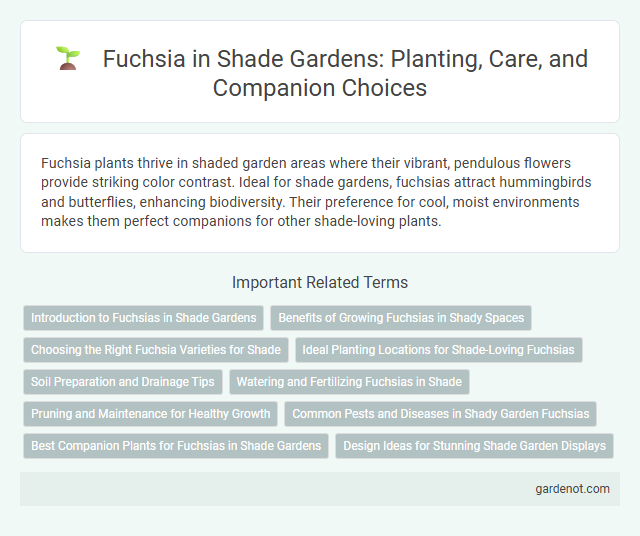Fuchsia plants thrive in shaded garden areas where their vibrant, pendulous flowers provide striking color contrast. Ideal for shade gardens, fuchsias attract hummingbirds and butterflies, enhancing biodiversity. Their preference for cool, moist environments makes them perfect companions for other shade-loving plants.
Introduction to Fuchsias in Shade Gardens
Fuchsias thrive in shade gardens due to their preference for indirect sunlight and cool, moist conditions. These flowering plants offer vibrant pendulous blooms in shades of pink, red, purple, and white, providing striking color contrasts in low-light areas. Their ability to attract hummingbirds and tolerate partial shade makes fuchsias an ideal choice for enhancing shaded garden spaces.
Benefits of Growing Fuchsias in Shady Spaces
Fuchsias thrive in shady gardens, offering vibrant, pendulous flowers that attract hummingbirds and pollinators, enhancing biodiversity. Their tolerance for low light and consistent moisture makes them ideal for understorey planting, contributing to soil health by preventing erosion. Growing fuchsias in shade provides extended bloom periods, adding continuous color to parts of the garden that typically receive less sunlight.
Choosing the Right Fuchsia Varieties for Shade
Selecting the right Fuchsia varieties for shade involves prioritizing cultivars that thrive in low-light conditions and maintain vibrant blooms without direct sunlight. Varieties such as Fuchsia magellanica and Fuchsia 'Dollar Princess' are renowned for their shade tolerance and prolific flowering, making them ideal for shaded gardens. Ensuring proper soil moisture and humidity supports these shade-loving Fuchsias in delivering colorful accents amid limited light environments.
Ideal Planting Locations for Shade-Loving Fuchsias
Fuchsias thrive best in partial to full shade environments, making them ideal for shaded garden beds, north-facing borders, or under the canopy of deciduous trees where indirect sunlight prevails. These plants require well-drained, fertile soil with consistent moisture, often benefiting from locations that provide morning sun and afternoon shade to avoid leaf scorch. Positioning fuchsias in sheltered spots protects them from harsh winds and extreme temperatures, promoting vibrant blooms and healthy foliage.
Soil Preparation and Drainage Tips
Fuchsia thrives in well-drained, fertile soil enriched with organic matter such as compost or leaf mold to retain moisture without waterlogging. Prior to planting, loosen the soil to a depth of at least 12 inches to promote root aeration and enhance drainage. Installing raised beds or incorporating coarse sand can significantly improve soil drainage, preventing root rot in shade garden environments.
Watering and Fertilizing Fuchsias in Shade
Fuchsias in shade require consistent moisture to thrive, so water them deeply once the top inch of soil feels dry, avoiding waterlogging to prevent root rot. Use a balanced, water-soluble fertilizer every two weeks during the growing season to enhance blooming and maintain vibrant foliage. Maintaining high humidity and well-draining soil enriched with organic matter supports optimal nutrient absorption and overall plant health.
Pruning and Maintenance for Healthy Growth
Pruning fuchsia plants in late winter or early spring encourages robust growth and abundant blooms by removing dead or weak stems. Regular pinching back of the tips during the growing season promotes bushier plants and prevents legginess. Consistent maintenance, including watering and feeding with balanced fertilizer, supports healthy development and vibrant flowers in shaded garden areas.
Common Pests and Diseases in Shady Garden Fuchsias
Fuchsia plants in shady gardens are commonly affected by pests such as aphids, whiteflies, and spider mites, which thrive in damp, sheltered environments. Fungal diseases like powdery mildew and rust frequently occur due to poor air circulation and persistent moisture in shaded areas. Effective management involves regular inspection, proper spacing for airflow, and the application of organic insecticides or fungicides to maintain healthy growth.
Best Companion Plants for Fuchsias in Shade Gardens
Hostas, astilbes, and heucheras thrive alongside fuchsias in shade gardens, enhancing the lush, cool environment these plants prefer. Ferns and begonias also complement fuchsias by adding diverse foliage textures and bright floral contrasts that flourish in low light. Combining these companions creates a vibrant, layered garden bed that maximizes shade tolerance and visual interest.
Design Ideas for Stunning Shade Garden Displays
Fuchsia plants thrive in shade gardens, offering vibrant, pendulous blooms that attract hummingbirds and add striking color contrast to darker spaces. Incorporate Fuchsia in hanging baskets or cluster them alongside hostas and ferns to create layered textures and dynamic visual interest. Utilizing varied Fuchsia cultivars with different bloom colors, such as deep purple, bright pink, and white, enhances depth and creates a captivating focal point in shaded garden areas.
Fuchsia Infographic

 gardenot.com
gardenot.com